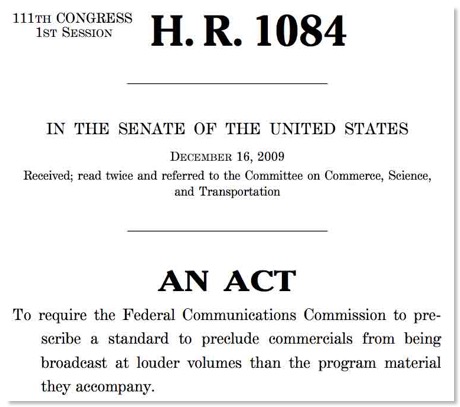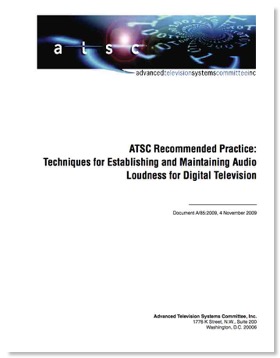Congress Finds Time to Mandate Regulation of TV Commercial Loudness
With the Congress deadlocked on all sorts of major issues and the Republicans threatening to stop all measures during the lame duck session except those related to global budget issues, they still had time to pass HR 1084/S 2847 described in the Senate committee report as follows:
The purpose of the Commercial Advertisement Loudness Mitigation Act, S. 2847, as reported, is to require the Federal Communications Commission (FCC) to incorporate into its rules by reference the standard developed by an industry standards-setting body for moderating the loudness of commercials in comparison to accompanying video programming.
This bill adds a new task to the FCC and provides no additions resources, either staffing or technical equipment budget - both of which are now in short supply. It does not hint how FCC might accomplish this goal at the expense of other goals which already have marginal resources. But the worse thing is that it probably will not even assuage the public who complain about loud TV commercials.
Complaints about loud commercials are long standing issue. Rob Cleveland and I have been reminiscing how this was a big topic when he came to work with me at FCC around 1982. CBS had just finished a large research program led by Bronwyn Jones on quantifying TV loudness with the aim of regulating it. The net result is that you could regulate the apparent loudness of many types of material, but no measurement technique consistently correlated with human perceptions when the program producer was creative. Since advertisers had a perverse incentive to be loud to get people’s attention, they could develop material that fooled the meter. Indeed, Ms. Jones demonstrate commercials to us that were the same sound level by any measure, but because of the nature of the visual content seemed louder.
Now with digital TV, there was a potential for the situation to get even worse. The Advanced Television Standards Committee described the problem:
The new law, assuming it is signed by the President, mandates adoption by FCC of the ATSC ‘‘Recommended Practice: Techniques for Establishing and Maintaining Audio Loudness for Digital Television’’ (A/85). This standard describes how to quantify audio loudness and then give a procedure to sending information to TV receivers to essentially adjust their volume control automatically to maintains a constant loudness. However, when one digs into the details of the standard, the remaining problem becomes clear. The technique used to quantify loudness is basically the same one used in the 1980s CBS system and is shown in the diagram below:Despite the conclusion of the DTV transition, many broadcasters and the production community have been slow to effectively adapt to the changes required to transition from analog NTSC audio techniques to contemporary digital audio practices. With digital television’s expanded aural dynamic range (over 100 dB) comes the opportunity for excessive variation in content when DTV loudness is not managed properly.
Consumers do not expect large changes in audio loudness from program to interstitials and from channel to channel. Inappropriate use of the available wide dynamic range has led to complaints from consumers and the need to keep their remote controls at hand to adjust the volume for their own listening comfort.
The NTSC analog television system uses conventional audio dynamic range processing at various stages of the signal path to manage audio loudness for broadcasts. This practice compensates for limitations in the dynamic range of analog equipment and controls the various loudness levels of audio received from suppliers. It also helps smooth the loudness of program-to- interstitial transitions. Though simple and effective, this practice permanently reduces dynamic range and changes the audio before it reaches the audience. It modifies the characteristics of the original sound, altering it from what the program provider intended, to fit within the limitations of the analog system.

Advertisers who want to be obnoxious and have loud attention getting commercials will structure their audio and video to fool the above measurement. The main effect of this new mandate may be that things just don’t get worse with the increased dynamic range of DTV.
The black boxes need for this are estimated by CBO to cost “from a few thousand dollars to about $20,000 per device”. TV stations will need 1-3 of these devices depending if they are transmitting secondary video streams. (If the market is big enough, custom ICs for this function could lower these costs significantly. But the potential market appears rather small.) The major impact, never mentioned in the Committee report or legislation, will be on small cable systems, who are also covered under this bill and will need a device for each channel that they either originate or insert advertising into. (Cable systems routinely insert advertising into many basic tier cable-only channels such as ESPN.)
So this well intentioned idea will tie up scarce FCC resources that could better be spent stimulating economic growth and will not accomplish its intended purpose. Other than that, it’s a good idea.
UPDATE
Clearly others do not share my skepticism on this piece of legislation:
Chmn. Genachowski:
“The CALM Act, a pro-consumer measure signed into law yesterday by President Obama, will help lower the volume on TV commercials. I commend the bill’s main sponsors, Representative Anna Eshoo and Senator Sheldon Whitehouse, for proposing the legislation, and thank the House Energy and Commerce Committee and Senate Commerce Committee for their leadership. The FCC will now focus on implementing the law to give consumers back the volume control on their TVs.”
Comm. Copps:
“During my tenure at the FCC, I have received literally hundreds of complaints about excessively loud TV commercials. Like millions of American viewers, I have had to suffer through this annoying practice, too. For years the best advice we could give aggravated TV viewers was to find the mute button! So I couldn’t be more pleased that President Obama has signed the Commercial Advertisement Loudness Mitigation Act (CALM Act) into law. I especially want to commend Representative Anna Eshoo and Senator Sheldon Whitehouse for introducing the legislation and for championing this common-sense measure through to final passage. This is a statute that clearly serves the public interest.”





![Validate my RSS feed [Valid RSS]](valid-rss-rogers.png)

